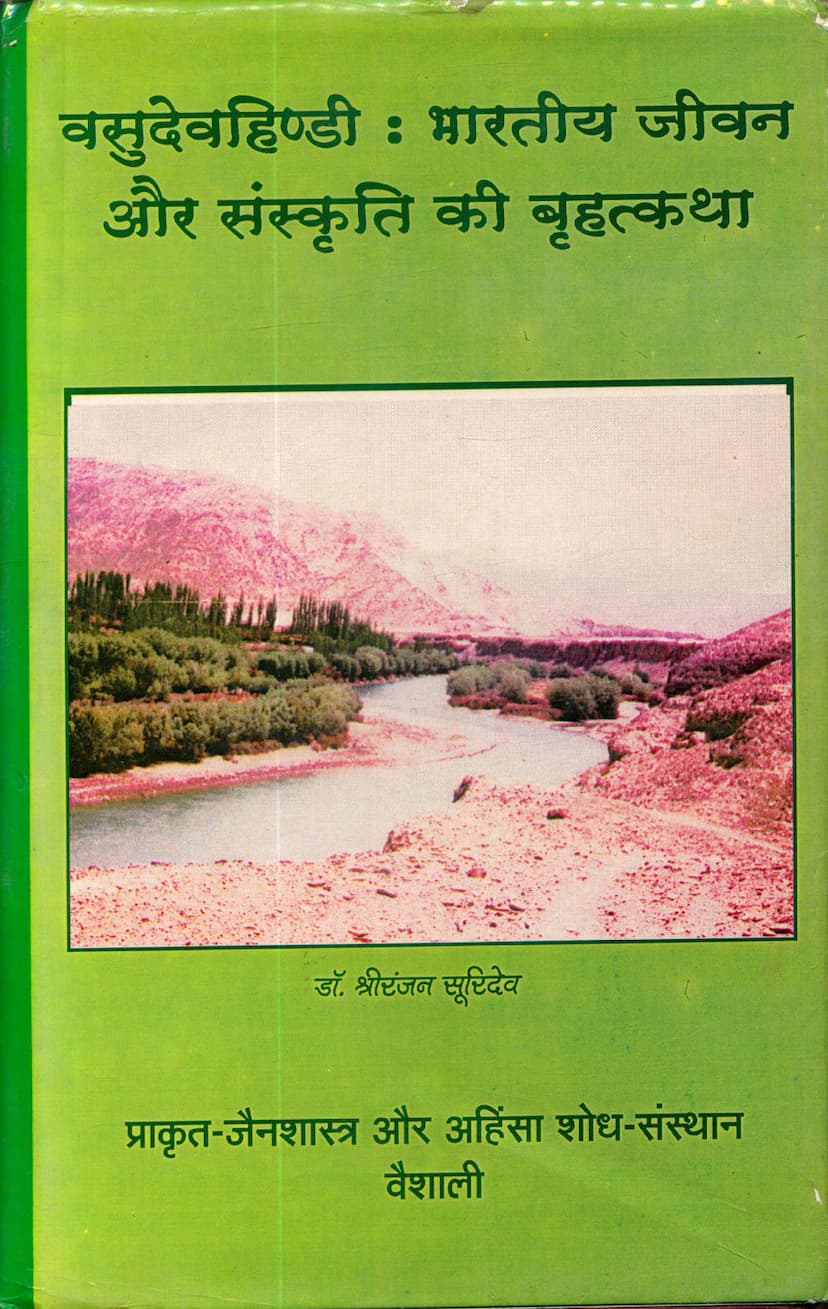Vasudevhindi Bharatiya Jivan Aur Sanskruti Ki Bruhat Katha
Added to library: September 2, 2025

Summary
This summary is based on the provided text, which appears to be the introductory and organizational sections of a scholarly work on the Jain text "Vasudevahindi".
Book Title: Vasudevahindi: Bharatiya Jivan Aur Sanskruti Ki Bruhat Katha (Vasudevahindi: A Great Narrative of Indian Life and Culture) Author: Dr. Shreeranjan Surideva Publisher: Prakrit Jain Shastra Aur Ahimsa Shodh Sansthan (Research Institute of Prakrit Jainology and Ahimsa), Vaishali Publication Year: 1993
Overall Nature of the Work: The book is a comprehensive PhD thesis by Dr. Shreeranjan Surideva, approved by the University of Bihar. It is presented as a significant research volume that illuminates the importance of the "Vasudevahindi" text. The author is lauded by respected scholars like Krishnadatta Vajpeyi and Dr. Ramji Singh for his deep understanding of Prakrit Jain literature and his contribution to enriching Jain literature through this study. The research is described as a commendable effort to reveal a valuable and previously less-known treasure trove within Prakrit narrative literature.
Key Aspects of "Vasudevahindi" as Explored in the Book:
-
Origin and Relationship to Brihatkatha: The "Vasudevahindi," composed by Acharya Sanghadasagani in the ancient Prakrit language, holds a distinct position in Oriental narrative literature. It is considered a Jain adaptation of Gunadhya's lost Paisaci-composed "Brihatkatha." Comparative study with other Brahmanical adaptations like Budhaswami's "Brihatkathashlokasangraha," Somadeva's "Kathasaritsagara," and Kshemendra's "Brihatkathamainjari" suggests that "Vasudevahindi" is closest to Gunadhya's original work in terms of story and structural technique.
-
Narrative Style and Techniques: The text utilizes the "drishtanta" (example/parable) style extensively, which is seen as a technique to maintain narrative interest and avoid monotony. The author's research delves deeply into the usage and significance of these illustrative narratives, finding them to be both reliable and astonishing.
-
Integration of Puranic and Jain Narratives: "Vasudevahindi" features stories related to Krishna, Rama, and other Puranic tales interspersed within its narrative. The author highlights the author's comparative analysis of Jain and Brahmanical Puranic narratives, finding them to be harmonious in their core essence despite external differences in description. It also includes traditional Jain narratives like the process of creation, origin of Vedas, origin of courtesans, etc.
-
Depiction of Indian Traditional Knowledge and Arts: The text serves as a repository of Indian traditional knowledge and arts, describing them practically. The author's research extensively covers the valuable material found regarding astrology, Ayurveda, Dhanurveda (archery/warfare), Vastu Shastra (architecture), Kamashastra (erotics), and fine arts.
-
Richness of Cultural and Social Depiction: "Vasudevahindi" is described as a "Mahakosha" (great treasury) of Indian life and culture, offering vivid glimpses into popular life. It provides unique geographical descriptions of cities, regions, countries, mountains, and rivers, shedding light on the path systems of ancient times and the flourishing nature of Mahajanapadas.
-
Insights into Religious, Political, and Economic Conditions: The text discusses philosophical viewpoints and religious practices of the time, offering valuable material for understanding the religious landscape. It also provides a broad analysis of political conditions, the lifestyles of royal families, and the economy of that era.
-
Linguistic and Literary Aspects: The book examines the linguistic richness and literary beauty of "Vasudevahindi." The author's scholarly analysis of its language and aesthetic qualities is considered unique. The language is noted to be close to Arsha Prakrit or the Ardhamagadhi of the Shvetambara Agamas. The study also touches upon the proximity of its language to Pali and potential influences of Paisaci language.
-
Structure of the Research: The book is divided into five main studies:
- Source and Form of Vasudevahindi: Discussing its origins, relationship with Brihatkatha, and its narrative structure.
- Puranic Narratives in Vasudevahindi: Analyzing Krishna, Rama, mythological, and miscellaneous stories, and their reinterpretation from a Jain perspective.
- Traditional Knowledge and Arts in Vasudevahindi: A comparative and critical study of subjects like astrology, Ayurveda, Dhanurveda, Vastu Shastra, and fine arts.
- Folk Life Reflected in Vasudevahindi: A detailed analysis of social and cultural life, administration, economy, geography, politics, and philosophical views.
- Linguistic and Literary Elements of Vasudevahindi: A linguistic and aesthetic evaluation, establishing its position as a seminal text in Indian narrative literature.
-
Appendices: The book includes appendices analyzing rare Prakrit word usage, details of Vasudeva's wives, Dhammilla's wives, and significant "charuchik" (interesting/memorable) places mentioned in the text.
Significance of the Book: The book is recognized for its in-depth research, drawing from related original sources to illuminate various facets of Indian culture. It is considered a vital contribution to the field of Prakrit and Jain studies, offering unparalleled scholarly scrutiny of "Vasudevahindi" and securing a top place for this analysis in the world of Prakrit language and literature research. The publication is sponsored by the Government of Bihar as part of its program to revitalize and reorient ancient learning.